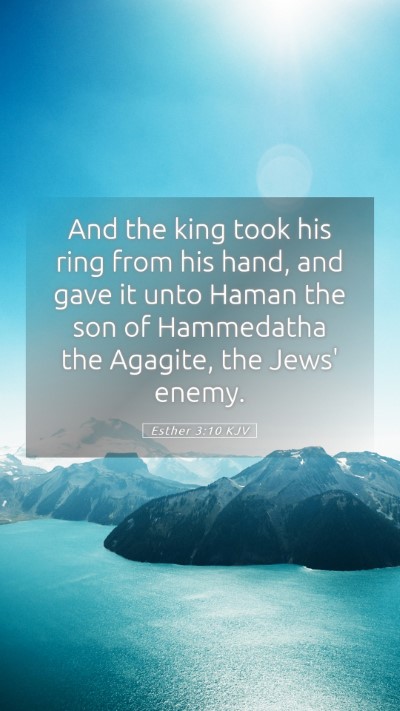Old Testament
Genesis Exodus Leviticus Numbers Deuteronomy Joshua Judges Ruth 1 Samuel 2 Samuel 1 Kings 2 Kings 1 Chronicles 2 Chronicles Ezra Nehemiah Esther Job Psalms Proverbs Ecclesiastes Song of Solomon Isaiah Jeremiah Lamentations Ezekiel Daniel Hosea Joel Amos Obadiah Jonah Micah Nahum Habakkuk Zephaniah Haggai Zechariah MalachiEsther 3:10 Meaning
What is the meaning of Esther 3:10?
And the king took his ring from his hand, and gave it unto Haman the son of Hammedatha the Agagite, the Jews' enemy.
Esther 3:10 Bible Verse Meaning
Bible Verse Commentary: Esther 3:10
Verse: Esther 3:10 - "So the king took his signet ring from his hand and gave it to Haman the son of Hammedatha the Agagite, the enemy of the Jews."
Understanding Esther 3:10
Esther 3:10 is a pivotal verse within the Book of Esther, marking a significant moment in the unfolding drama where Haman, a high-ranking official, is granted authority to enact his malevolent plans against the Jewish people. This verse encapsulates themes of power, authority, and the consequences of hatred and prejudice.
Commentary Insights
-
Matthew Henry's Commentary:
Matthew Henry emphasizes the gravity of King Ahasuerus' decision to give Haman his signet ring, symbolizing the transfer of authority. This act not only endorses Haman's hostility toward the Jews but also highlights the dangers of unchecked power. Henry cautions readers about the ease with which evil can proliferate when leaders act without justice or insight.
-
Albert Barnes' Notes:
Barnes points out the significance of Haman's lineage, identifying him as an Agagite, which connects him to a long-standing enmity between the Amalekites and Israelites. This historical context is crucial for understanding Haman's motivations and the animosities that fuel his actions. Barnes interprets this verse as a culmination of previous conflicts, illustrating the ongoing struggle between good and evil.
-
Adam Clarke's Commentary:
Clarke provides an analysis of the implications of the king's actions in granting authority to Haman. He reflects on how personal biases and favorites can corrupt royal decisions, leading to detrimental outcomes for entire communities. Furthermore, Clarke urges readers to recognize how this moment initiates a series of events that eventually lead to the deliverance of the Jews through Esther, highlighting God's providence even in dire circumstances.
Historical Context
The Book of Esther takes place during the Exile of the Jews in Persia, illustrating the struggles faced by the Jewish people. Esther, a Jewish woman, becomes queen, and her position is critical as the plot unfolds. Recognizing the importance of context, Esther 3:10 serves not only as a narrative turning point but also as a reflection of the broader themes of persecution and divine intervention prevalent throughout Jewish history.
Application of Esther 3:10
This verse may prompt readers to reflect on the following:
- Exercising Authority Responsibly: Just as Ahasuerus handed over his ring to Haman, today's leaders must exercise their authority with justice and compassion, fostering an environment of equity and respect.
- The Consequences of Hatred: Haman's animosity towards the Jews exemplifies how prejudice can lead to societal decay. This illustrates the need for individuals and communities to confront biases, striving for unity and understanding.
- Divine Providence: Despite Haman's malevolence, the narrative unfolds to reveal God's overarching plan for the deliverance of His people. This provides hope for believers facing persecution or adversity.
Cross References
The themes and events in Esther 3:10 can be further understood in light of the following cross-references:
- 1 Samuel 15:1-3: The historical enmity between the Amalekites (Haman's ancestry) and Israel.
- Esther 7:10: The downfall of Haman serves as a turning point in the narrative.
- Hebrews 11:32-34: Acknowledgment of faith amidst trials, relating to the Jewish struggle portrayed in Esther.
Conclusion
Esther 3:10 is more than just a historical account; it provides profound Bible verse meanings and valuable biblical exegesis that invite readers to engage in in-depth Bible verse analysis. The understanding of Scripture presented through this verse encourages deeper contemplation on authority, good versus evil, and the ever-present providence of God.


